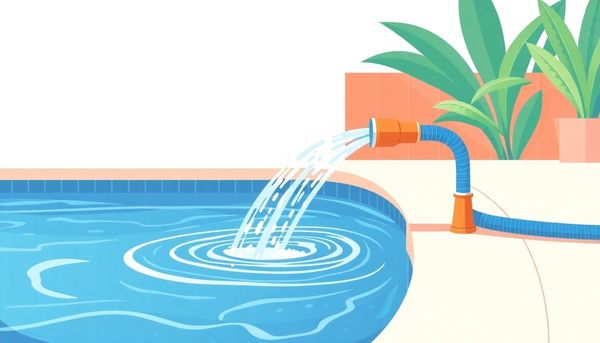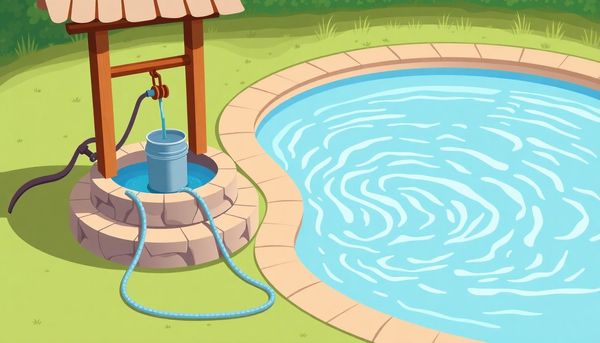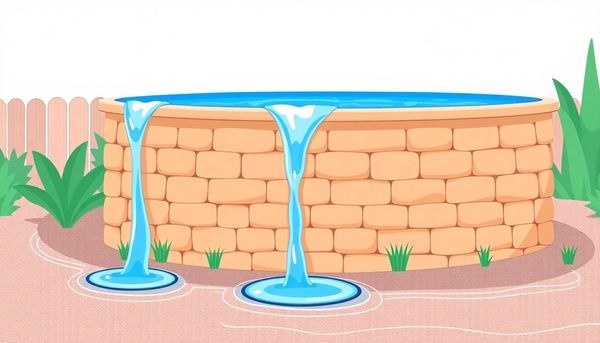Budget-Friendly Pool Refilling: Smart Tips to Save Water and Money
February 06th, 2024
February 06th, 2024
Owning a pool is often seen as the pinnacle of backyard luxury, but the reality of maintaining it can be less glamorous. The sun is shining, kids are splashing, and the dog is barking at the inflatable flamingo—everything seems perfect until you glance at the water level and realize it's time for a refill. Perhaps the bill from last month's water consumption is still haunting you, or maybe you're just looking for smarter ways to manage your resources. Whatever the reason, refilling your pool on a budget doesn't have to be a daunting task.
First, consider the source of your water. Many are unaware that local water companies sometimes offer discounts for filling pools, especially during off-peak seasons. Checking in with a neighbor who’s recently filled their pool might lead to some surprising insights. Then, there’s the matter of rain. A well-positioned tarp can catch significant amounts of rainfall, turning a few rainy days into several inches of pool water.
Community connections can also play a role. A friend once told me about a local Facebook group where neighbors shared excess water from their wells. It’s an unconventional approach but one that showcases the power of community sharing. With a bit of creativity and resourcefulness, refilling your pool without breaking the bank is not just feasible—it’s a chance to redefine how you approach this quintessential summer chore.

Using well water for your pool can be a real game-changer for your budget. If you're lucky enough to have a well with a solid water yield, you might find yourself smiling at the prospect of filling up your pool without watching your dollars swirl down the drain. It’s like finding a hidden stash of treasure right in your backyard. However, before you start pumping away, there are a few quirks about well water you should know.
Unlike city water that’s been treated and filtered, well water often carries a unique cocktail of minerals. These minerals, like iron and manganese, can create a myriad of challenges. You might notice an unusual scent or taste, courtesy of hydrogen sulfide. These elements, while naturally occurring, can be a headache for pool maintenance by interfering with chlorine levels and causing unsightly stains. Testing your well water before filling your pool is a must; a simple kit can help you identify any problematic substances.
You should also consider the capacity of your well. Is it up to the task of filling a large backyard pool? Running a well dry is a costly mistake, potentially requiring a new well to be drilled. Additionally, if your pool is your water source's only burden, you might get away with using it, but remember the toll it can take on your pump and filtration systems. With a bit of diligence and preparation, well water might just be your ticket to a budget-friendly pool season.
For those blessed with access to a well, tapping into this resource can be a financially savvy way to refill your pool. Unlike city water, well water doesn’t come with a monthly bill, making it an enticing option for the budget-conscious pool owner. However, before you start pumping water into your backyard oasis, there are some vital considerations to keep in mind.
First and foremost, it’s essential to test your well water for impurities. Unlike municipal sources, well water is untreated, often carrying minerals like iron, sulfur, and manganese. These can wreak havoc on pool equipment, causing stains or scaling, and can complicate chemical balance. My neighbor once filled his pool with well water only to discover cloudy water and unsightly stains; a costly lesson in the importance of pre-testing.
Another critical factor is the well’s capacity. While the water might be free, overtaxing your well can lead to a dry spell—literally. Drawing too much water too quickly can drain your well, leaving you with a hefty bill for repairs or a new well drill. It's a bit like trying to host a dinner party with a single pot of soup; eventually, you’ll run out.
Lastly, consider your well pump’s health. Filling a pool demands a substantial volume of water, potentially pushing your pump to its limits. Regular maintenance and possibly upgrading your equipment can help avoid unexpected breakdowns.
Balancing these elements can help you take advantage of your well’s natural bounty while ensuring your pool remains a sparkling retreat.
Refilling your pool with well water can be an enticing, cost-effective option, especially when you own a well with the capacity to supply the significant volume needed. However, a brief stroll down the lane of well-water usage reveals a few crucial considerations that shouldn't be overlooked. For instance, well water often arrives with a unique bouquet of minerals. These uninvited impurities like hydrogen sulfide, iron, and copper can wreak havoc on your pool's chemistry, turning a simple refill into a complex balancing act. Left unchecked, these minerals might cloud your water or stain your pool surfaces, which leads to additional costs down the line.
To avoid such pitfalls, testing is your best ally. Before that first drop of well water graces your pool, invest in a comprehensive water test kit. This ensures you're aware of any unwanted elements and can plan the appropriate chemical treatments beforehand. Remember, prevention is always better than a cure, especially when it comes to preserving your pool’s health.
Beyond chemistry, consider the physical demands on your well system. The volume required to fill a pool is substantial, and overtaxing a well pump can lead to costly repairs or replacements. If your well is the sole water source for your home, a softener system might already be in place. This can alleviate mineral concerns but at the cost of wear and tear on the system itself. Factor in the cost of extra salt and electricity, ensuring the math still works in your favor. By taking these steps, you can enjoy the financial benefits of well water without compromising your pool’s integrity.
When it comes to maintaining pool water levels, prevention and preservation are your best allies. The small, everyday strategies that protect your pool from losing water can also protect your wallet. One simple yet effective trick is using a solar pool cover. Not only does it cut down on evaporation, but it also keeps debris out, reducing the need for frequent cleanings. A friend of mine swears by her cover; it’s saved her from topping off her pool more times than she can count.
Mind the landscaping around your pool as well. Strategically placed trees and shrubs can act as windbreaks, minimizing evaporation due to wind. I once helped a neighbor plant a row of aromatic lavender bushes around his pool—now his water levels stay stable and his yard smells incredible.
Don’t overlook the impact of potential leaks. A small, unaddressed leak can lead to significant water loss over time. Regularly inspect your pool’s liner and plumbing for any signs of wear. My cousin discovered a tiny tear during a routine check, and fixing it quickly saved him a hefty water bill.
Lastly, encourage gentle entry into the pool. Those epic cannonballs might be fun, but they can also send gallons of water cascading over the edge. Balancing fun with mindfulness ensures your pool stays full and your costs stay low. These simple tweaks can make a big difference in maintaining your pool water levels efficiently.

When refilling your pool, smart planning is key to conserving water and trimming costs. Consider adopting a rainwater collection system. With a few strategically placed barrels, you can harness the power of nature’s bounty. This method not only saves money but also enriches the eco-friendly credentials of your home. A friend of mine managed to collect enough rainwater during a particularly wet spring to fill half of their pool, slashing their water bill significantly.
Additionally, scheduling your fill-up during non-peak hours can lead to substantial savings. Many municipalities offer lower water rates at night, when demand is lower. It might seem inconvenient, but setting up your garden hose before bedtime and letting it work its magic overnight can result in a pleasant surprise next time you check your utility bill.
Moreover, keep an eye out for local water conservation programs. Some regions provide incentives or rebates for those who take measures to reduce their water consumption. These programs may include discounts on water-saving devices or services. By staying informed and taking advantage of such opportunities, you can not only save money but also contribute to a more sustainable community.
Ultimately, with a bit of creativity and foresight, refilling your pool can become a less daunting and more affordable task, turning a potential financial drain into a savvy household project.
When it comes to refilling your pool water without breaking the bank, thinking outside the box can make all the difference. Pool water delivery doesn't have to be a costly affair; it can be optimized by considering a blend of various resources. Firstly, assess your existing water sources. If you have access to a municipal water supply, a simple call to your utility company could enlighten you on any special rates or exemptions you might qualify for, such as removing sewage fees during a pool refill.
Alternatively, if your household relies on well water, you may find yourself in a favorable position financially. However, be sure to monitor your well's capacity and quality closely. Testing for minerals like iron and copper upfront can prevent future headaches and unnecessary expenses related to water treatment. This not only saves money but also preserves the integrity of your pool's equipment and lining.
For those without a viable well, local water delivery services offer convenience at a price. However, shopping around for quotes from different companies can yield surprisingly competitive rates. Balancing these options with the cost of city water might highlight a more economical choice.
Ultimately, a thoughtful approach to pool water delivery can safeguard both your finances and your pool’s longevity. By leveraging local resources wisely, you can enjoy refreshing swims without the worry of escalating costs.
Engaging with well water can be a savvy move for pool owners looking to save a buck or two. For those with access to a private well, the idea of using it to fill a pool might sound like a jackpot of savings. Consider my neighbor, who relished the thought of utilizing his well water for just this purpose. However, he hadn’t bargained for the peculiarities of mineral-rich water.
Well water often brims with minerals like iron, copper, and sulfur, which naturally seep into the water table. These elements, while harmless for the most part, can become a pool owner's nightmare. That rustic iron tint might lend charm to a country kitchen but will leave unsightly stains on pool liners and surfaces. Moreover, the presence of sulfur can tamper with your pool's chemical balance, making maintenance a bit of a juggling act.
It's crucial to test your well water for these minerals before committing to a full pool fill-up. A simple sample sent to a local lab can save you headaches—and dollars—down the line. Additionally, ensure your well can provide the necessary volume without running dry, as drilling a new well is neither quick nor cheap.
Ultimately, while the initial cost of using well water may be low, the ongoing maintenance and potential equipment wear-and-tear require thoughtful consideration. So, if you're planning to go the well water route, prepare for a little extra TLC to keep your pool sparkling and your budget intact.
Every drop counts when it comes to conserving water and saving money on pool refills. When faced with the prospect of replenishing your pool, the goal should be to use water wisely, avoiding unnecessary expenses. Begin by keeping a close eye on evaporation. A simple solar pool cover can be your ally, reducing water loss dramatically. It’s not just about blocking the sun; it offers a physical barrier that prevents water from drifting away with the wind. For those cooler months, a liquid solar cover can add another layer of protection, slowing down evaporation without the hassle of removing a solid cover.
Next, consider the possibility of leaks. It might surprise you how much water—and money—can escape through even the smallest undetected leaks. Regularly check for damp spots around your pool, and if you notice the water level dropping more than usual, it might be time to investigate further. Once identified, a quick repair can save thousands of gallons in the long run.
Finally, be mindful of unnecessary splashing. While fun is the essence of a pool day, gentle reminders to the family can make a big difference. Even turning off water features when they’re not in use can prevent unintended losses. By combining these simple strategies, you ensure that your pool stays full and your wallet stays protected. With a bit of attention and care, you’ll be the proud owner of a pool that’s both full and fiscally friendly.

The thrill of owning a pool can quickly evaporate when faced with unexpected expenses, especially those creeping from hidden leaks. A seemingly innocent trickle can transform into a financial whirlpool, draining both your budget and enthusiasm. To keep those leaks from turning your pool into a money pit, vigilance is key.
Start by making regular inspections a habit. Check for signs like uneven water levels or wet patches around the pool area, as these can be subtle hints of underlying issues. Investing in a quality pool cover can also pay dividends by reducing evaporation, which often mimics leak symptoms. A simple dye test near suspicious areas can reveal whether it's a genuine leak or just thirsty summer air.
In my own experience, a small tear near the skimmer once went unnoticed until my water bill skyrocketed. A quick patch job saved me hundreds in the long run. If you're not confident in your DIY leak-detective skills, don't hesitate to call in a professional. They can locate and fix problems swiftly, preventing potential structural damage that could cost even more to repair.
While the upfront cost of repairs might sting, it's a smart trade-off for preserving not just your water but also the integrity of your pool. A stitch in time saves nine, as they say, and in this case, it also saves your wallet.
When it comes to pool refills, exploring less conventional sources can save bucks and resources. Instead of defaulting to municipal water, consider using rainwater. If you live in an area with a decent amount of rainfall, setting up a rainwater harvesting system could be a game changer. A couple of strategically placed barrels or a more sophisticated catchment system can collect rainwater for free and store it until you need it for your pool. This not only reduces your water bill but also makes use of an otherwise wasted resource.
Another approach involves making friends with local farmers. Many farms have access to large water reserves, sometimes in the form of irrigation ponds. With permission, you could strike a deal to tap into this supply. It’s a win-win situation: you get affordable water, and the farmer gains a bit of extra income. Just ensure the water quality meets pool standards.
Lastly, for those with a creative flair, consider greywater recycling. This involves repurposing water from household activities like laundry and dishwashing. Though it requires some setup and strict adherence to safety standards, using filtered greywater for non-potable purposes like pool refills can dramatically slash water costs.
Each of these options has its own set of pros and cons. A bit of research and planning can lead you to the most cost-effective choice tailored to your situation.
Establishing water-conservation strategies not only helps Mother Nature, but it also keeps your wallet in check. A friend once told me about how she managed to refill her pool without breaking the bank. Instead of a costly complete refill, she opted for partial refills and prioritized maintaining the existing water. This approach saved her a ton of cash, not to mention keeping environmental impact to a minimum.
Starting with a pool cover, you can significantly reduce evaporation, which can waste hundreds of gallons a year. A solar pool cover, for instance, not only cuts down on water loss but also helps retain heat, reducing the need to crank up the pool heater. If you’re in a particularly windy area, consider planting hedges or installing windbreaks. These natural barriers keep the breeze—and thus the evaporation—at bay.
Additionally, regular maintenance can uncover leaks before they become budget-busting issues. Check your pool’s walls and plumbing regularly and promptly address any issues. When backwashing your filter, be mindful of water usage. Only backwash when necessary and keep an eye on that sight glass.
Even small lifestyle changes, like moderating splashy play, make a difference. Gently remind your pool party guests that every cannonball represents lost water—and lost savings. By integrating these steps into your pool routine, you’ll manage water levels effectively and affordably while enjoying a pristine swimming experience.
The subtle sound of constant dripping isn't just an annoyance—it can be a tug on your wallet. Addressing pool-leak issues promptly not only preserves water but also saves money in the long run. Picture this: a small, seemingly harmless leak can result in a significant loss of water over weeks or even days. If your pool's water level is dropping more than an inch daily without any obvious splash-prone activities, it’s time to suspect a leak.
Discovering the source of the leak can feel like finding a needle in a haystack, but it’s essential. Start by examining the pool’s shell, plumbing, and equipment. If you’re not inclined to do it yourself, consider hiring a pool professional. Though upfront costs may seem daunting, the investment often pays off through substantial savings on water bills and preventing potential structural damage.
A friend once faced a similar issue and hesitated to fix it, thinking it was minor. Months later, he discovered the water leakage had eroded parts of the surrounding soil, leading to expensive repairs. Prompt action could have prevented the escalation. Hence, if you notice suspicious water loss, act quickly. A simple dye test or a call to a pool expert can halt a small problem before it makes a big splash in your finances. Keeping your pool well-maintained not only conserves water but also ensures that your summer fun stays afloat without unexpected interruptions.

Think of solar covers as your pool's secret weapon for saving both water and money. These covers act like an invisible shield, reducing the evaporation that chips away at your pool’s water supply—and your finances—every day. On average, an uncovered pool can lose about a quarter-inch to half-inch of water daily just to evaporation. Over a year, this translates to potentially thousands of gallons vanishing into thin air.
A solar cover is essentially a giant, floating blanket that traps heat and maintains water temperature, all while cutting evaporation rates by up to 95%. Not only does it save water, but it also reduces the need to crank up the pool heater, which can dramatically lower your energy bills. This dual action of conserving both water and power makes solar covers an incredibly cost-effective solution.
In cooler months or if you’re looking for an alternative, consider adding a liquid solar cover to your pool maintenance routine. This innovative product forms a microscopic barrier on the water's surface, providing some level of protection against evaporation, although not as effective as a physical cover.
My neighbor swears by the solar cover he bought last summer. After initial skepticism, he noticed a noticeable drop in his water bill and fewer trips to the store for pool chemicals. It’s a straightforward, one-time investment with long-term benefits, sparing both your wallet and the environment. By incorporating this simple tool, you not only extend the life of your pool water but also enjoy the satisfaction of a greener, more economical pool experience.
Refilling your pool should not drain your wallet. The trick is to harness cost-effective water sources that align with your resources and needs. If you're lucky enough to have access to a well, you're in good shape to fill your pool at zero cost per gallon. However, well water comes with its own set of considerations. Not only should you confirm your well's capacity to handle the volume, but you also need to test the water quality. Unwanted minerals like iron or the notorious sulfur smell might mean a higher maintenance cost down the line. A friend once tried this, and while the idea of 'free water' was appealing, the subsequent expenses on chemicals to balance the pool out were not.
For those without a well or facing tight municipal water restrictions, consider a rainwater collection system. It's an investment upfront, but over time, it could pay off handsomely. My neighbor installed a simple setup using barrels and gutters, and he swears by how much he saves on his water bills each summer. However, local regulations on rainwater harvesting should be checked beforehand since they can vary widely.
Another option is to strike a deal with a local farm or business with a surplus water supply. Some businesses have water they need to offload, which can be a win-win situation if you negotiate wisely. When my uncle needed to refill his pool, he teamed up with a nearby nursery that had an excess they couldn't store. They were happy to deliver the water at a fraction of what he would have paid otherwise.
Ultimately, the key is to explore your surroundings and think creatively about water sources. With a bit of ingenuity, you can splash around in your pool without splashing out your savings.
Preserving your pool isn’t just about water quality or aesthetics; it’s a financial safeguard. A well-maintained pool not only offers endless fun but also ensures your investment remains sound. Consider my friend Alex, who thought he could put off minor repairs. A slight leak during summer turned into a costly repair job by fall. That’s why regular check-ups are crucial to avoid such pitfalls.
Water conservation begins with smart choices. Using a solar cover, for instance, can significantly reduce evaporation—a sneaky culprit that drains not only water but also your wallet. During those long, sunny days, evaporation can rob your pool of hundreds of gallons. A one-time expense on a solar cover can lead to substantial savings over time.
Landscaping isn't just for beauty; strategic placement of plants or barriers minimizes wind exposure, thus curbing evaporation further. I recall a neighbor who planted tall shrubs around his pool. Not only did it add privacy, but it also kept the water levels more stable during breezy days.
Finally, always address leaks immediately. A tiny crack might seem harmless but can escalate into major issues. If you’re unsure, call a professional. It's a worthy expense that will save you from unexpected costs down the line. Protecting your pool investment isn’t just good practice; it’s essential for those seeking to enjoy their aquatic haven without financial worry.
Conserving your pool's water is akin to guarding a treasure chest, ensuring that each drop stays where it belongs—within your pool. One of the sneakiest culprits of water loss is evaporation, which can siphon off up to half an inch of water daily. This seemingly harmless process can lead to thousands of gallons lost each year. Investing in a solar pool cover not only combats evaporation but also helps maintain your pool’s temperature. Augment this with a liquid solar cover during cooler months to further bolster your defenses.
Landscaping around your pool can serve as an unexpected ally in this conservation battle. Strategically placed shrubs or fences act as windbreakers, minimizing water loss and keeping leaves and debris at bay. Additionally, maintaining a vigilant eye on your pool’s water level is crucial. Significant daily decreases might signal a leak, which should be promptly addressed to prevent further water (and money) from slipping away.
Splashing undeniably adds to the charm of pool sides but can also lead to substantial water loss. Encourage mindful playtime and regulate water features like fountains or jets to operate only when necessary. Finally, maintain your pool equipment, especially filters, with care. Efficiently backwashing a filter prevents unnecessary water drainage—keeping your oasis full and your wallet fatter. By implementing these practices, you're not just preserving water; you're keeping your pool in top condition while minimizing refill costs.

In the world of pool maintenance, the art of keeping water inside the pool often goes unnoticed. Yet, minimizing splashing is a savvy strategy to cut costs. Remember that time when your uncle's legendary cannonball sent a tidal wave over the edge? While entertaining, each drop that escapes the pool equates to dollars down the drain.
Controlling splash-outs can be achieved by setting some simple ground rules. Encourage pool users to channel their inner dolphins with graceful entries and exits rather than tidal waves. This doesn't mean squashing fun; instead, it’s about finding balance. For instance, designate a splash zone for those exuberant jumps. This allows for fun without compromising your water levels too drastically.
Moreover, it's not just enthusiastic swimmers that can be the culprits. Consider features like fountains or waterfalls. These can be beautiful but also notorious for spilling water. Adjusting the flow or limiting their operation can save gallons over time. If practical, install splash guards or barriers designed to redirect water back into the pool.
Even the smallest adjustments contribute to significant savings. By keeping the water where it belongs, you’re not just conserving a resource—you’re also maintaining the chemical balance, reducing the need for costly water treatments. With a bit of mindfulness, you can keep your pool full, your budget intact, and your guests entertained.
Crafting an effective pool fill-up strategy requires more than just turning on a hose and hoping for the best. It's about balancing cost, resources, and time to create the most economical approach for your situation. First, consider your locale and its water conditions. Are you in a drought-prone area where water costs skyrocket during the dry season? Or perhaps you're lucky enough to reside in a region with abundant rainwater that you could harness with a collection system?
Let's talk numbers. Calculating the exact volume of your pool is crucial. More than once, I've seen folks under or overestimate their pool's capacity, leading to unnecessary expenses or headaches when the water bill arrives. Use an online calculator or the classic tape-measure method and make sure you're armed with accurate figures before starting.
Now, think creatively. If well water is accessible, it might seem like a free-for-all, but it’s not without its pitfalls. Make sure your equipment is up to the task, and always test well water for minerals that could wreak havoc on your pool chemistry. If city water is your only option, contacting your local utility to discuss rates can unveil potential discounts, especially if they waive sewage fees for pool fills.
Lastly, timing is everything. Filling your pool during off-peak hours might avoid straining your local supply and your wallet. By planning thoughtfully, you transform this chore into a savvy, cost-effective task, leaving you more funds for summer fun.

This article provided insights into maintaining your pool. Start your pool care journey today!
Want to become a pool maintenance expert? Our free Pool School course covers everything you need to know about pool care. From basic maintenance to advanced troubleshooting, you'll learn how to:
Join over 10,000 pool owners who have already transformed their pool care routine. Get started with our free Pool School course today!